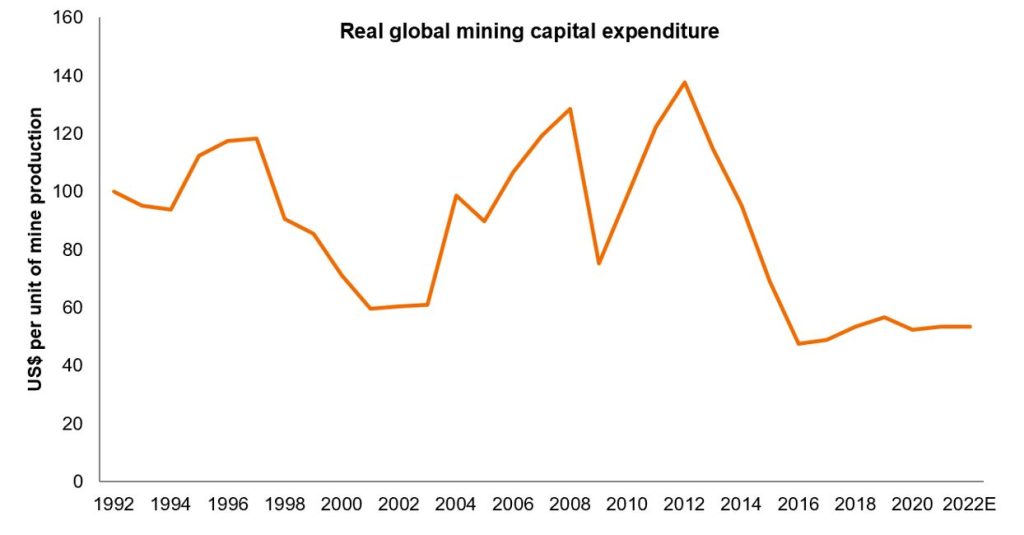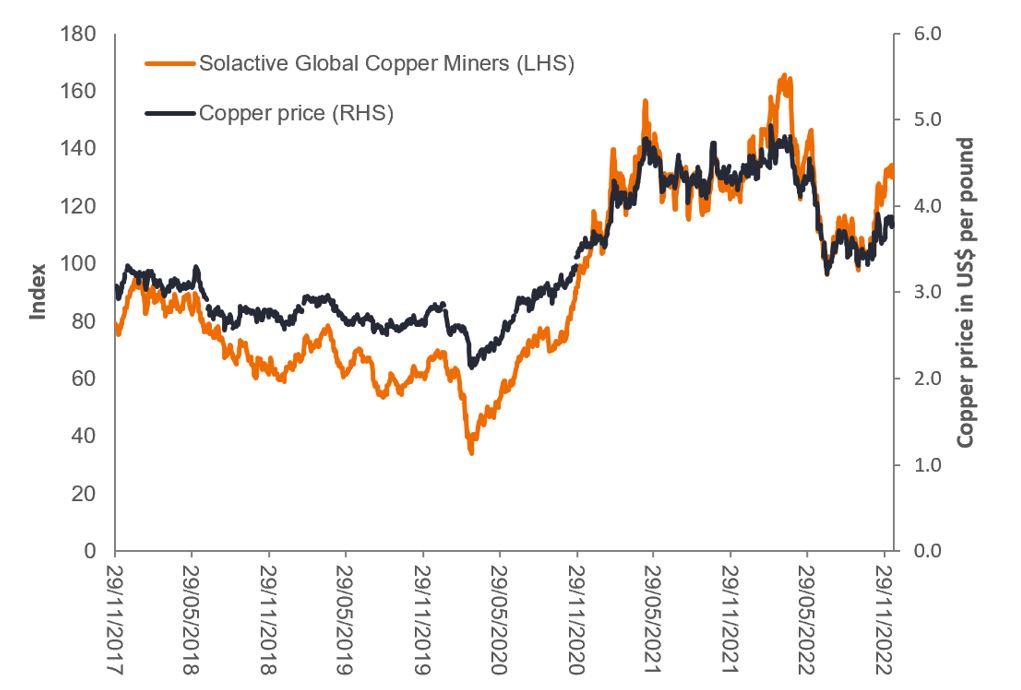Two big resources opportunities for 2023 (and one less so)
There’s no sugar-coating it, 2022 was a poor year for global equity markets, which were down around 7%(1) in Australian dollars. War, inflation, and central banks’ war on inflation dominated headlines and investor sentiment for much of 2022.
Faring comparatively better, the natural resources sector displayed a characteristically low correlation to broader global equities, with the sector(2) up an enviable 22% for the year.
Why were resources spared 2022’s woes?
Breaking down performance into the three sub-sectors that make up the S&P Global Natural Resources Index, mining returned 4.7%, while energy outperformed due to the unfolding energy supply crisis in Europe, returning 29.6%. Agriculture had a more subdued year, returning -0.3%.
Resources weren’t spared from market volatility, but many of the companies we consider to be high quality names, with world class assets, low costs of production and strong balance sheets have managed to pull themselves back from their 2022 lows.
Despite the issues dominating investment markets, the long-term investment thematics for natural resources remain compelling. Many resource companies have unique assets that are both hard to replicate and critical to meeting global demand.
The megatrends of decarbonisation, accelerating population growth and urbanisation continue to underpin the long-term investment case. This is as the world continues toward net zero, while simultaneously catering to billions of people’s food, housing, and infrastructure needs. These trends will provide additional demand pressures for metals, energy, and agricultural output well into the future.

An emerging theme to watch
An important theme we’ve identified is a lack of capital expenditure to meet growing resource demand. Ultra-low commodity inventory levels and benign growth in supply have driven prices of virtually all commodities up, and we don’t believe mining, energy or agriculture companies are investing sufficient capital to meet growing demand.

As global demand rebounds, markets will be faced with low inventories and constrained supply which could drive commodity prices, boosting profit margins and encouraging resources companies to invest in growth and expansion.
The search for new supply will drive a merger and acquisition cycle and we are keeping a close eye on opportunities that could benefit, such as gold miners, Northern Star (ASX: NST) and Evolution Mining (ASX: EVN). Investors often ignore the acquisition cycle until it is well established.
Gold and green metals’ outlook is positive, while iron ore is less certain
Gold companies continue to discover and develop profitable projects, and after being de-rated in the market over the past two slow years, some gold company shares are now trading at attractive valuations. Over the past few months, gold found support around US$1600/oz., before quickly moving to US$1800/oz.
In our view, the most promising long-term metal is copper as it is essential to electrifying the economy as the growth of renewable energy continues. Despite the strong long-term demand for copper, we took advantage of short-term price volatility by selling out of some copper company positions before re-purchasing at large discounts to the sale price as prices have since retraced.

We believe there are only a small number of sizeable, high quality, publicly traded copper companies, and we hold them when the price is right. Ivanhoe Mines (TSE:IVN) has an exceptional high-grade copper mine and have a very efficient operation. Locally, Sandfire Resources (ASX: SFR) is building a new mine and earlier this year, it made a transformative acquisition in Spain.
As a vital raw material for batteries to power electric vehicles and store renewable energy, lithium has seen continued strong demand. Following a previous price cycle, Lithium has enjoyed a significant boom in 2022 and we expect demand to continue to grow given countries’ commitment to decarbonisation and carmakers’ commitment to phase out internal combustion engines over the coming years.
The outlook for iron ore is less certain, finishing 2022 at its lowest price for a few years. Demand from Chinese steel manufacturers should pick up in 2023 as China re-opens and commits to supportive action for property development markets and infrastructure expansion.
That said, there is significant uncertainty as to when this will take place and we can’t necessarily assume China will return to pre-pandemic activity levels.
The potential for a global recession is also a significant risk to watch for as it would dampen demand for iron ore, along with many other commodities.
Energy sector – an outlier year on the path to net zero?
The price for oil and gas has been dramatically affected by Russia’s invasion of Ukraine and the resultant trade sanctions and cuts to Europe’s gas supplies from Russia. This is likely to be a long-term issue, and we don’t believe Europe’s reliance on Russian oil and gas is likely to return.
2022 has been a catalyst year for nations to seek energy security and they are increasingly looking to domestic renewable energy as a solution.
Adding momentum to this trend is a combination of economic incentives and government policy, such as the Inflation Reduction Act in the US. This will likely see new wind, solar and hydrogen projects announced, along with greater infrastructure to support electric vehicles.
China’s oil demand will grow significantly when its economy opens. However, new supplies are expensive to find and build, and the oil market remains very tight, with little spare capacity. Therefore, oil will remain an important commodity market for some time, and as the easy-to-develop discoveries are depleted, higher prices are likely to remain in place.
We believe progressive companies like Hess (NYSE: HES), AkerBP (NO:AKRBP), Birchcliff (TSE:BIR) and ARC Resources (TSE:ARX) have good growth coming from successful exploration and development work and are likely to benefit in this tightening environment.
We expect to see more nuclear projects announced as a reliable foundation for many countries’ energy mix. In the wake of the European energy crisis, nuclear could also provide energy security for many countries reliant on importing their oil and gas.
Many of the uranium developers are smaller companies, and incentive pricing in uranium of US$60-US$80+ is needed to see significant new supply come to the market. We believe New Energy Materials (ASX: NXE) has a world-class deposit and could benefit from growing nuclear adoption.
Agriculture – Strong long-term fundamentals
Population growth continues unabated, with the world’s 8,000,000,000th person born in mid-November, and projections for another 500,000,000 people to be added to the world’s population by 2030.
Despite often being the forgotten resources sector, we see tight agricultural markets for the foreseeable future, with all areas of production needed to feed, house and clothe the growing masses.
In the short-term, ‘stock to use’ ratios for wheat, corn and soybeans have suffered from a combination of drought in China, the USA and Europe, coupled with the Russian invasion of Ukraine, which is a significant provider of agricultural products to the rest of the world. Even if more normal weather patterns return, it is likely to take multiple harvest seasons to rebuild stocks and ease tight markets.
These dynamics bode well for farm economics and providers of crop inputs like seeds, fertilisers, and crop chemicals. Companies with outstanding assets and expansion capacities, such as Nutrien (TSE:NTR), The Mosaic Company (NYSE: MOS), Archer-Daniels-Midland (NYSE: ADM) and FMC Corporation (NYSE: FMC), should be well positioned to grow aggressively into this expanding market.
Also, smaller fresh food producers are developing robust business practices to enable profitable growth, like Costa Group (ASX: CGC) in berries and other fruit and vegetables, SalMar (OSE:SALM) in salmon and Synlait (NZX:SML) in high value milk powders.
Supply and demand dynamics a positive for resources
Strong commodity demand and constrained supply growth will continue to support commodity prices and drive returns in natural resources companies. We believe current valuations don’t reflect the strong structural long-term demand for all segments of natural resources.
In our view, the natural resources sector remains attractive. It has a P/E ratio of less than 10x, and dividend yields are over 4%(3). In addition, many companies in the sector have greatly simplified their operating models, have little or no debt, and are experiencing generally elevated commodity prices, high profits and cash flows.
Remaining well-diversified across quality global natural resources companies that have the resilience to weather challenging short-term market conditions, but are well-placed to benefit from the longer-term structural changes taking place in the sector is key to success in this evolving market.
Learn more about the future of resources
We invests in high quality mining, energy and agriculture companies with flexibility to invest across the supply chain, taking advantage of price shifts between upstream and downstream sectors and across industries. Visit our fund profiles below to learn more..


1 topic
10 stocks mentioned
2 funds mentioned



